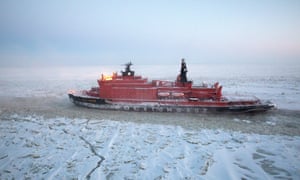- President orders plan for Arctic and Antarctic in 60 days
- Military experts sceptical of ‘icebreaker gap’ with Russia

Photograph: Alexander Ryumin/TASS
Donald Trump has ordered the construction of a fleet of icebreakers and bases to pursue US interests in the Arctic and Antarctic by the end of the decade in a signal that his administration is going to take a more aggressive approach to the contest with Russia and China for polar resources.
Trump issued a memorandum on “safeguarding US national interests in the Arctic and Antarctic regions” which calls on the administration to come up with a plan within 60 days that would include at least three heavy icebreakers to be built by 2029, and recommendations for locations to build two support bases in the US and two on foreign soil.
The memorandum appeared designed to expand and inject extra urgency into a longstanding US Coast Guard plan to build three heavy and three medium icebreakers. It suggests the US look into leasing arrangements while the new fleet is being built.
“This appears to be another rapid study to confirm or perhaps expand what the US needs,” said Heather Conley, senior vice-president for Europe, Eurasia and the Arctic at the Centre for Strategic and International Studies. “Again, how to pay for it is another question that will need to be answered another day.”
The US currently has just one heavy icebreaker, the ageing Polar Star, and one medium. Russia currently has 40 breakers in total, Finland has seven, and Canada and Sweden have six each.
As the sea ice is melting, China is also laying claim to Arctic resources, although it does not have an Arctic coastline, by funding various infrastructure projects.
Trump’s memorandum said the new icebreaker fleet would be used for “the full range of national and economic security missions (including the facilitation of resource exploration and exploitation and undersea cable laying and maintenance)”.
The US study is to explore the potential for a nuclear-powered icebreaker, and “defensive armament adequate to defend against threats by near-peer competitors”.
The US Coast Guard commander has said that they may need surface-to-air missiles to defend US territory against Russia and China.
“It was also new that the US will seek two US domestic bases (one must be in Alaska, I assume) and international bases, presumably one in the south and one in the north,” Conley said. “Set against the backdrop of fears that the US is withdrawing forces from Europe and US funding requirements for basing support, this may not be too easy of a sell at the moment to our allies.”
The aim of the polar security review is also meant to “include the ability to provide a persistent United States presence in the Antarctic region” adding that such presence would be “in accordance with the Antarctic Treaty System”, which requires that the region “be used for peaceful purposes only”.
The intensifying rivalry over sea routes and mineral resources in the Arctic, itself a consequence of the climate emergency, has caused alarm over its environmental impact.
“Even during a pandemic and nationwide protests against state violence, the Trump administration is still finding new ways to exploit the climate crisis. He is truly the worst president for the planet we’ve ever had,” Charlie Cray, a senior researcher for Greenpeace USA, said.
“There are so many ways our tax dollars could be used to support Arctic communities. Helping out the oil industry and the military with a new fleet of icebreakers is definitely last on the list.”
Polar military experts are also sceptical over the urgency of the “icebreaker gap” with Russia.
“Icebreakers – even if armed – don’t really address some of the most commonly cited challenges that China and Russia might pose for the United States in the Arctic,” Paul Avey, assistant professor for political science at Virginia Tech university, argued. “This isn’t to say icebreakers can play no role in competition. But in narrow defence terms, I think that the best way to address China and Russia in the Arctic – and Antarctic – is to focus on issues in eastern Europe and the western Pacific.”



